How MNCs Improve Recruitment, Selection, and Training of Employees
VerifiedAdded on 2021/02/20
|42
|4574
|23
Project
AI Summary
This project investigates how multinational companies (MNCs) enhance their employee recruitment, selection, and training processes to meet international requirements. The research aims to identify current trends, effective strategies, and challenges faced by organizations, with a specific focus on Nestle as a case study. The project outlines a detailed project management plan, including scope, cost, communication strategies, and risk assessments. The methodology involves face-to-face interviews and questionnaires, employing a convenience sampling strategy with HR managers from Nestle. Data analysis utilizes both qualitative and quantitative methods, presenting findings through themes, frequencies, and interpretations. Key themes explored include awareness of recruitment trends, the ability of organizations to meet international requirements, the promotion of a learning culture, the importance of competitive workforces, and the effectiveness of on-the-job training. The research concludes with recommendations for further improvements in employee recruitment, selection, and training within MNCs.
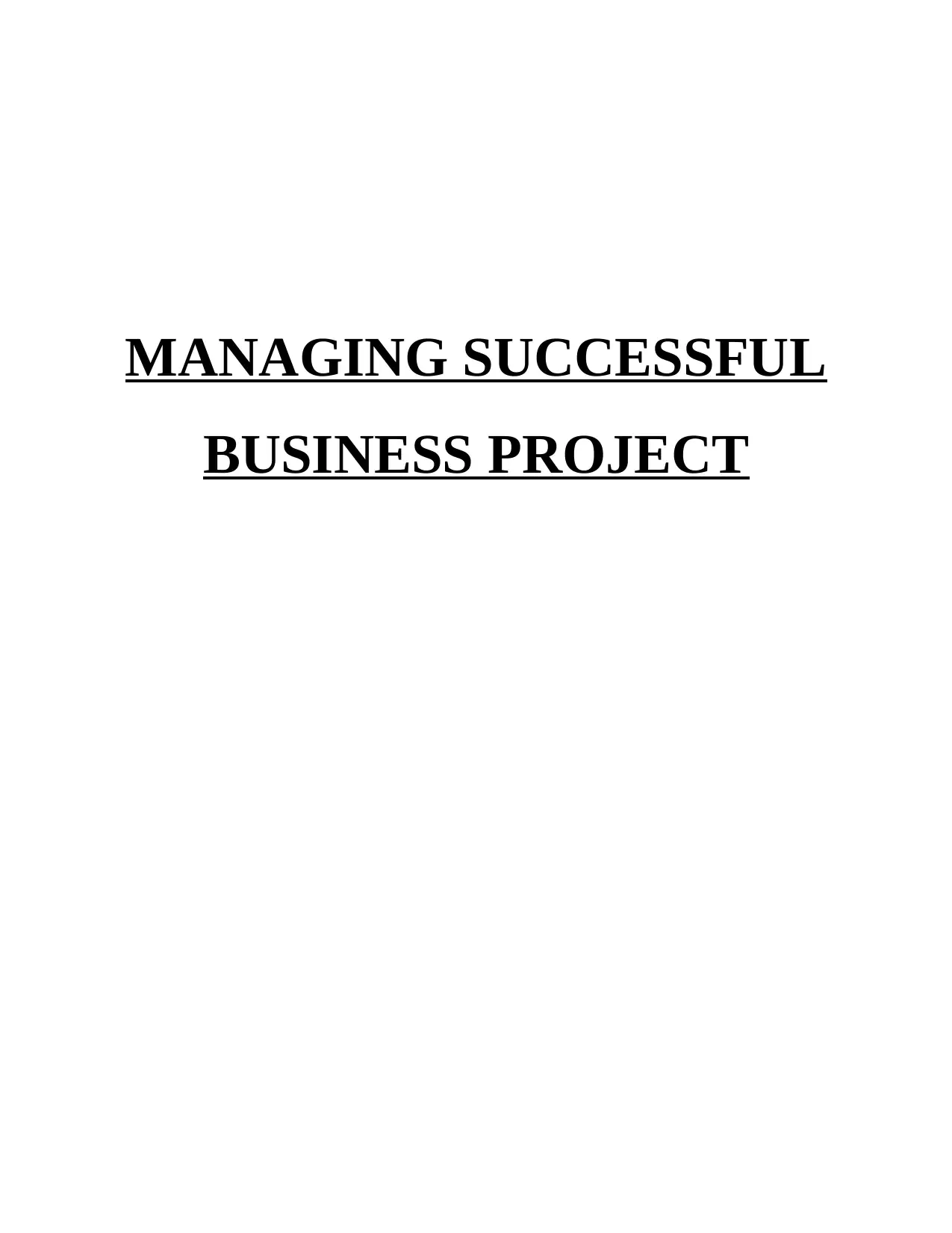
MANAGING SUCCESSFUL
BUSINESS PROJECT
BUSINESS PROJECT
Paraphrase This Document
Need a fresh take? Get an instant paraphrase of this document with our AI Paraphraser
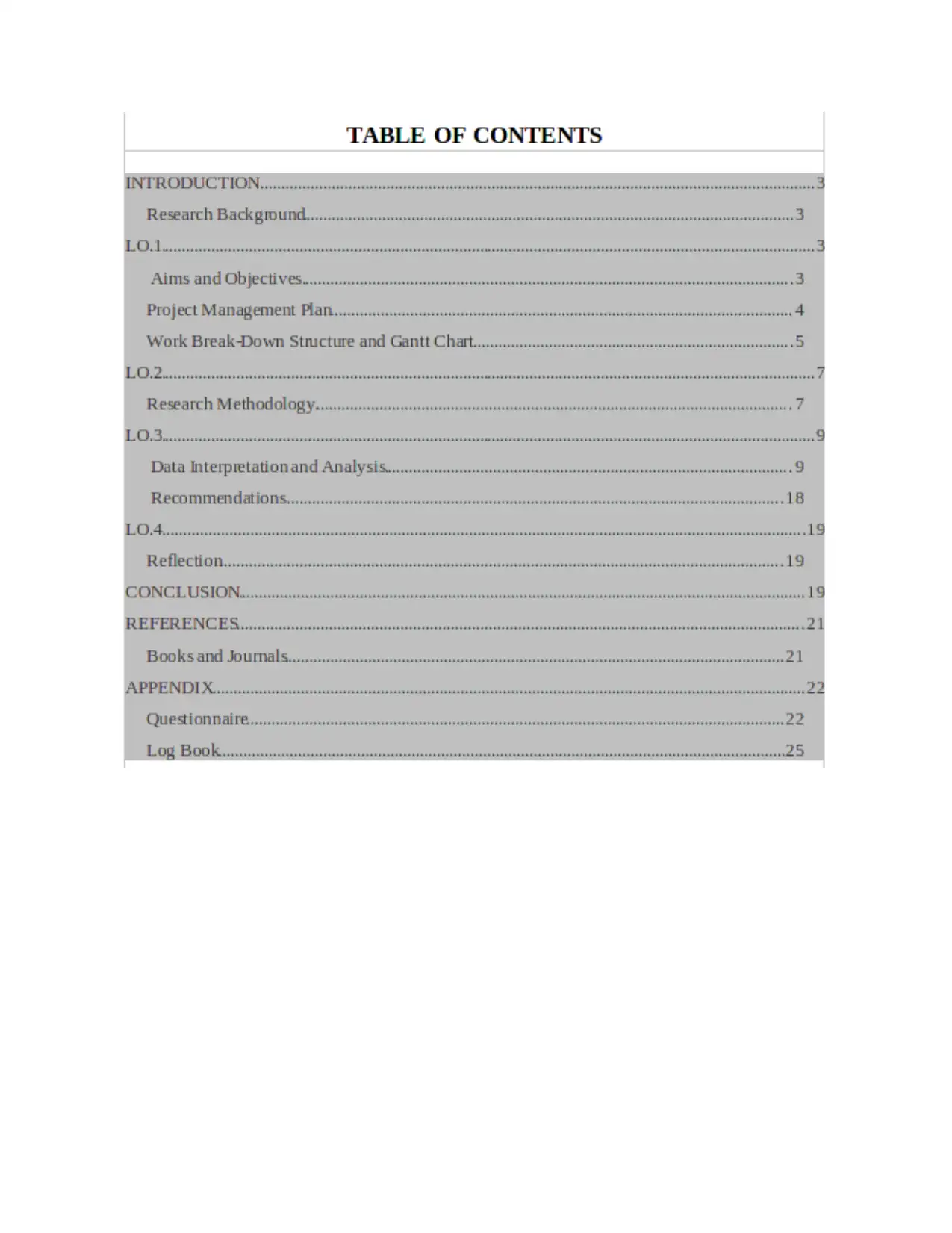
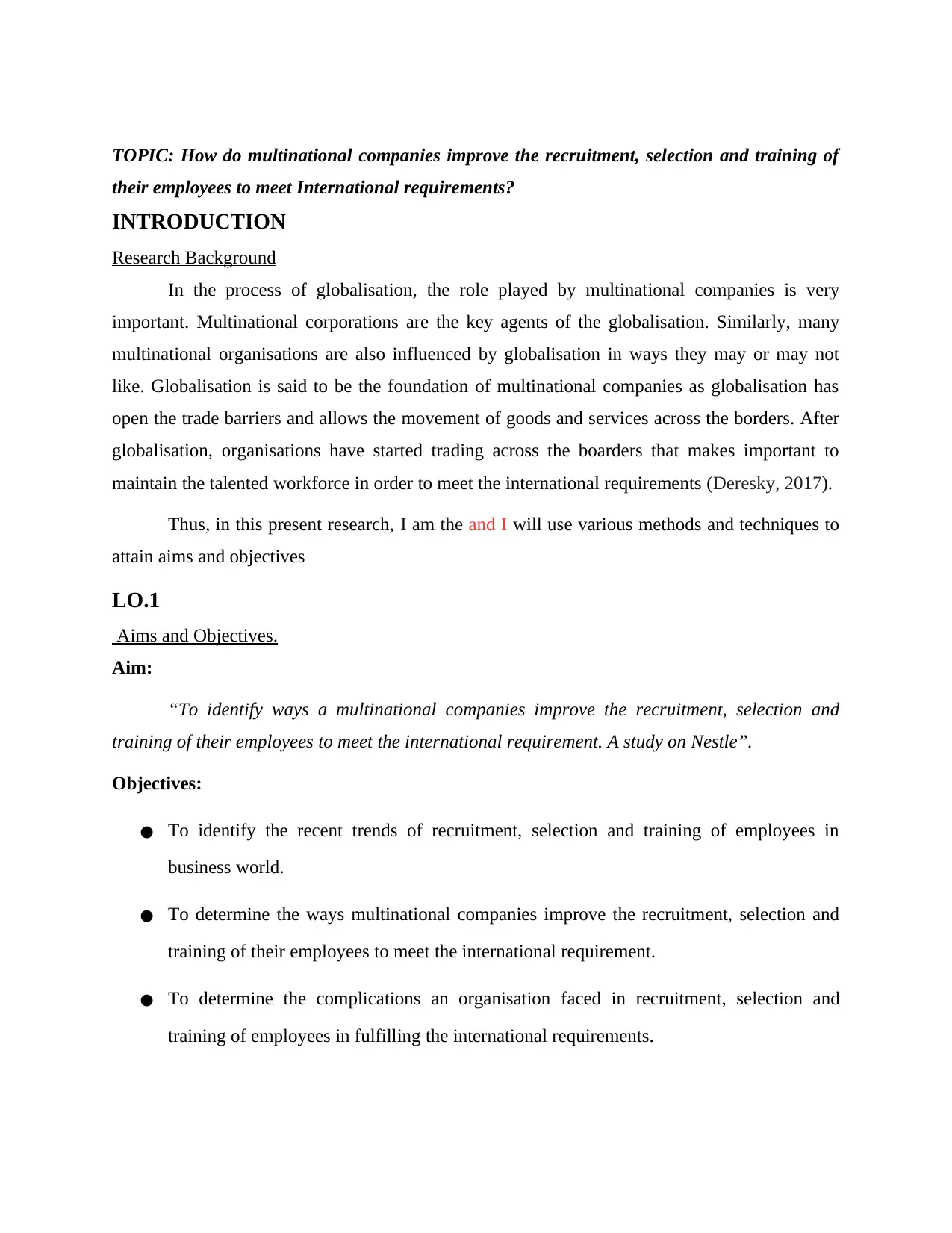
TOPIC: How do multinational companies improve the recruitment, selection and training of
their employees to meet International requirements?
INTRODUCTION
Research Background
In the process of globalisation, the role played by multinational companies is very
important. Multinational corporations are the key agents of the globalisation. Similarly, many
multinational organisations are also influenced by globalisation in ways they may or may not
like. Globalisation is said to be the foundation of multinational companies as globalisation has
open the trade barriers and allows the movement of goods and services across the borders. After
globalisation, organisations have started trading across the boarders that makes important to
maintain the talented workforce in order to meet the international requirements (Deresky, 2017).
Thus, in this present research, I am the and I will use various methods and techniques to
attain aims and objectives
LO.1
Aims and Objectives.
Aim:
“To identify ways a multinational companies improve the recruitment, selection and
training of their employees to meet the international requirement. A study on Nestle”.
Objectives:
● To identify the recent trends of recruitment, selection and training of employees in
business world.
● To determine the ways multinational companies improve the recruitment, selection and
training of their employees to meet the international requirement.
● To determine the complications an organisation faced in recruitment, selection and
training of employees in fulfilling the international requirements.
their employees to meet International requirements?
INTRODUCTION
Research Background
In the process of globalisation, the role played by multinational companies is very
important. Multinational corporations are the key agents of the globalisation. Similarly, many
multinational organisations are also influenced by globalisation in ways they may or may not
like. Globalisation is said to be the foundation of multinational companies as globalisation has
open the trade barriers and allows the movement of goods and services across the borders. After
globalisation, organisations have started trading across the boarders that makes important to
maintain the talented workforce in order to meet the international requirements (Deresky, 2017).
Thus, in this present research, I am the and I will use various methods and techniques to
attain aims and objectives
LO.1
Aims and Objectives.
Aim:
“To identify ways a multinational companies improve the recruitment, selection and
training of their employees to meet the international requirement. A study on Nestle”.
Objectives:
● To identify the recent trends of recruitment, selection and training of employees in
business world.
● To determine the ways multinational companies improve the recruitment, selection and
training of their employees to meet the international requirement.
● To determine the complications an organisation faced in recruitment, selection and
training of employees in fulfilling the international requirements.
⊘ This is a preview!⊘
Do you want full access?
Subscribe today to unlock all pages.

Trusted by 1+ million students worldwide
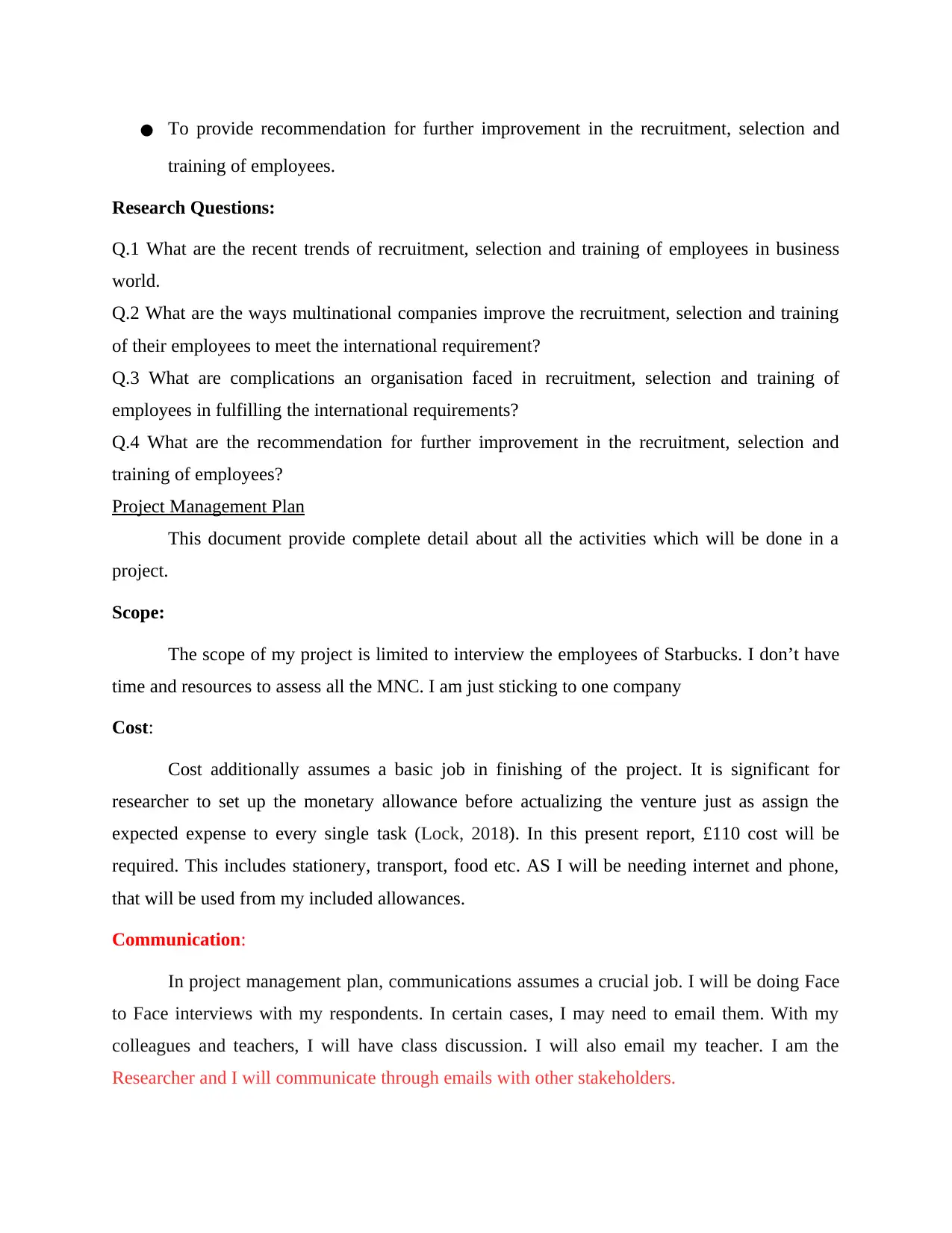
● To provide recommendation for further improvement in the recruitment, selection and
training of employees.
Research Questions:
Q.1 What are the recent trends of recruitment, selection and training of employees in business
world.
Q.2 What are the ways multinational companies improve the recruitment, selection and training
of their employees to meet the international requirement?
Q.3 What are complications an organisation faced in recruitment, selection and training of
employees in fulfilling the international requirements?
Q.4 What are the recommendation for further improvement in the recruitment, selection and
training of employees?
Project Management Plan
This document provide complete detail about all the activities which will be done in a
project.
Scope:
The scope of my project is limited to interview the employees of Starbucks. I don’t have
time and resources to assess all the MNC. I am just sticking to one company
Cost:
Cost additionally assumes a basic job in finishing of the project. It is significant for
researcher to set up the monetary allowance before actualizing the venture just as assign the
expected expense to every single task (Lock, 2018). In this present report, £110 cost will be
required. This includes stationery, transport, food etc. AS I will be needing internet and phone,
that will be used from my included allowances.
Communication:
In project management plan, communications assumes a crucial job. I will be doing Face
to Face interviews with my respondents. In certain cases, I may need to email them. With my
colleagues and teachers, I will have class discussion. I will also email my teacher. I am the
Researcher and I will communicate through emails with other stakeholders.
training of employees.
Research Questions:
Q.1 What are the recent trends of recruitment, selection and training of employees in business
world.
Q.2 What are the ways multinational companies improve the recruitment, selection and training
of their employees to meet the international requirement?
Q.3 What are complications an organisation faced in recruitment, selection and training of
employees in fulfilling the international requirements?
Q.4 What are the recommendation for further improvement in the recruitment, selection and
training of employees?
Project Management Plan
This document provide complete detail about all the activities which will be done in a
project.
Scope:
The scope of my project is limited to interview the employees of Starbucks. I don’t have
time and resources to assess all the MNC. I am just sticking to one company
Cost:
Cost additionally assumes a basic job in finishing of the project. It is significant for
researcher to set up the monetary allowance before actualizing the venture just as assign the
expected expense to every single task (Lock, 2018). In this present report, £110 cost will be
required. This includes stationery, transport, food etc. AS I will be needing internet and phone,
that will be used from my included allowances.
Communication:
In project management plan, communications assumes a crucial job. I will be doing Face
to Face interviews with my respondents. In certain cases, I may need to email them. With my
colleagues and teachers, I will have class discussion. I will also email my teacher. I am the
Researcher and I will communicate through emails with other stakeholders.
Paraphrase This Document
Need a fresh take? Get an instant paraphrase of this document with our AI Paraphraser
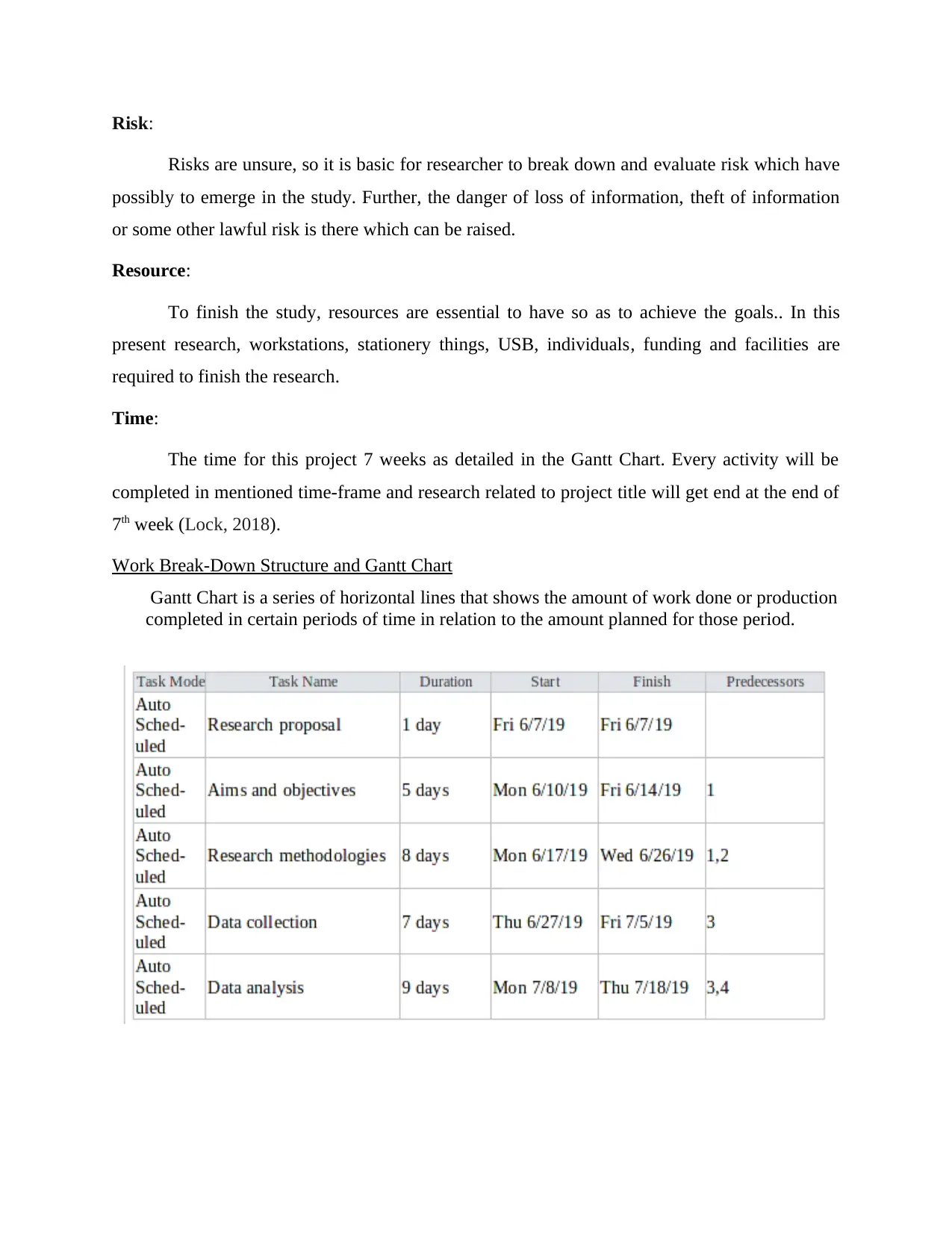
Risk:
Risks are unsure, so it is basic for researcher to break down and evaluate risk which have
possibly to emerge in the study. Further, the danger of loss of information, theft of information
or some other lawful risk is there which can be raised.
Resource:
To finish the study, resources are essential to have so as to achieve the goals.. In this
present research, workstations, stationery things, USB, individuals, funding and facilities are
required to finish the research.
Time:
The time for this project 7 weeks as detailed in the Gantt Chart. Every activity will be
completed in mentioned time-frame and research related to project title will get end at the end of
7th week (Lock, 2018).
Work Break-Down Structure and Gantt Chart
Gantt Chart is a series of horizontal lines that shows the amount of work done or production
completed in certain periods of time in relation to the amount planned for those period.
Risks are unsure, so it is basic for researcher to break down and evaluate risk which have
possibly to emerge in the study. Further, the danger of loss of information, theft of information
or some other lawful risk is there which can be raised.
Resource:
To finish the study, resources are essential to have so as to achieve the goals.. In this
present research, workstations, stationery things, USB, individuals, funding and facilities are
required to finish the research.
Time:
The time for this project 7 weeks as detailed in the Gantt Chart. Every activity will be
completed in mentioned time-frame and research related to project title will get end at the end of
7th week (Lock, 2018).
Work Break-Down Structure and Gantt Chart
Gantt Chart is a series of horizontal lines that shows the amount of work done or production
completed in certain periods of time in relation to the amount planned for those period.
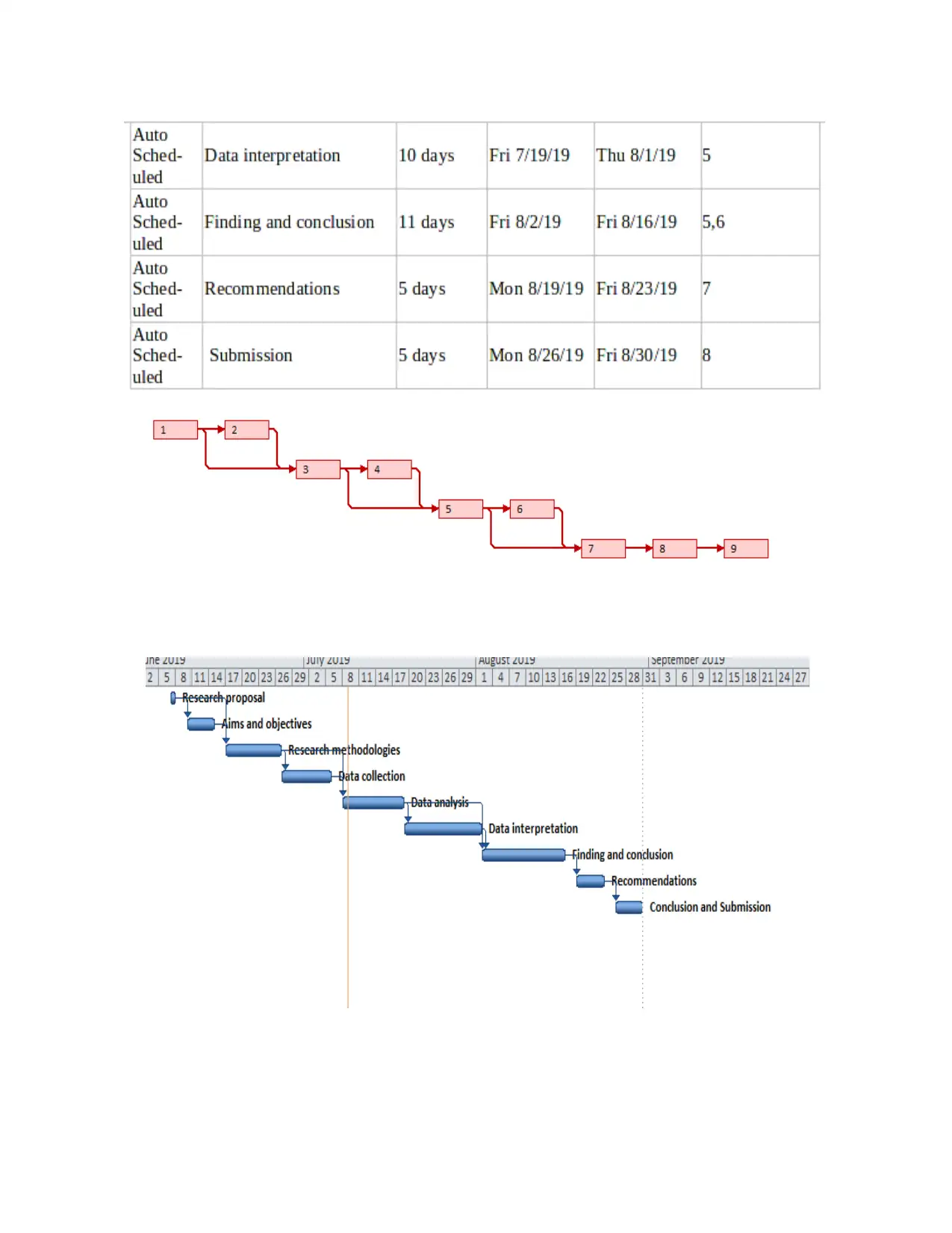
⊘ This is a preview!⊘
Do you want full access?
Subscribe today to unlock all pages.

Trusted by 1+ million students worldwide
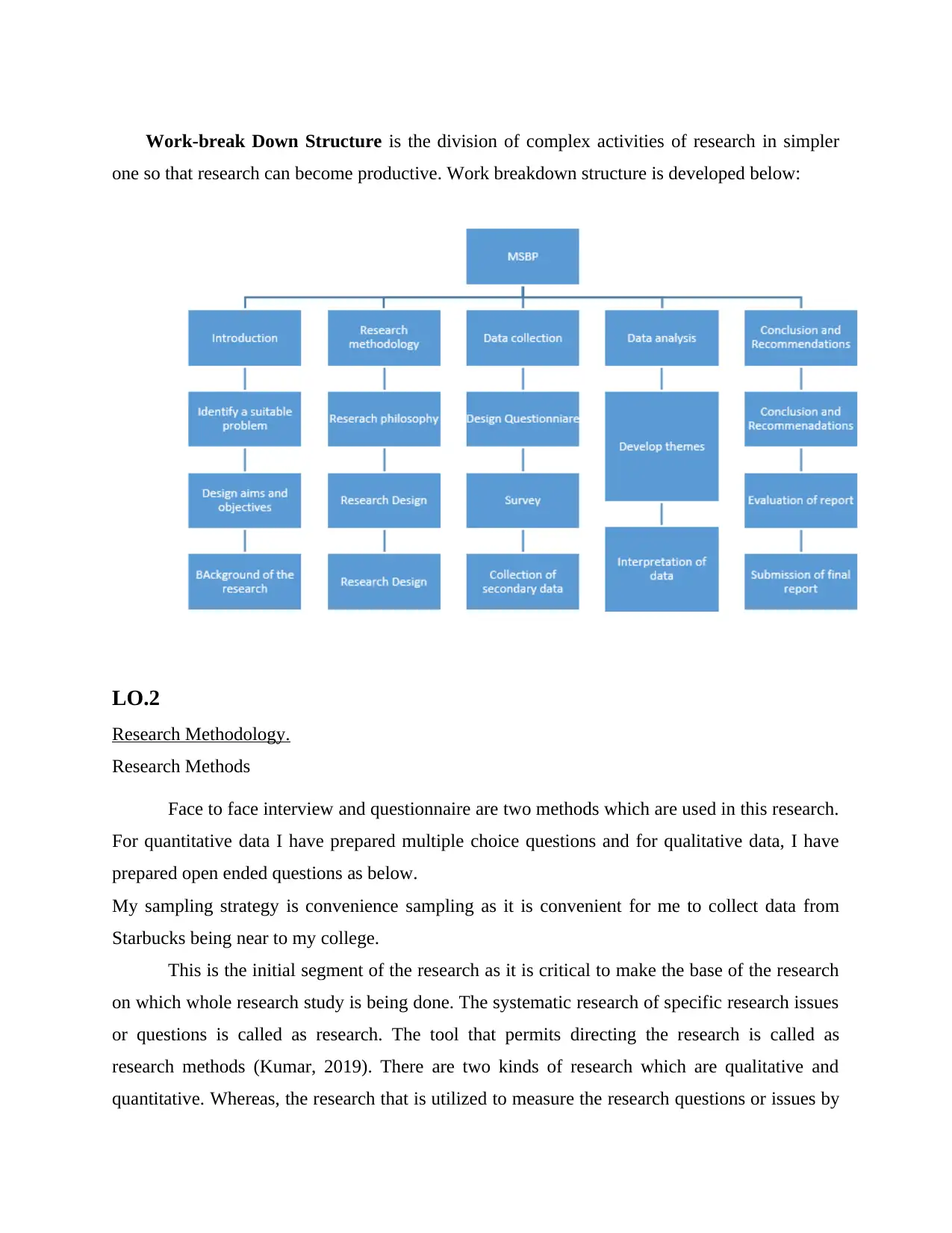
Work-break Down Structure is the division of complex activities of research in simpler
one so that research can become productive. Work breakdown structure is developed below:
LO.2
Research Methodology.
Research Methods
Face to face interview and questionnaire are two methods which are used in this research.
For quantitative data I have prepared multiple choice questions and for qualitative data, I have
prepared open ended questions as below.
My sampling strategy is convenience sampling as it is convenient for me to collect data from
Starbucks being near to my college.
This is the initial segment of the research as it is critical to make the base of the research
on which whole research study is being done. The systematic research of specific research issues
or questions is called as research. The tool that permits directing the research is called as
research methods (Kumar, 2019). There are two kinds of research which are qualitative and
quantitative. Whereas, the research that is utilized to measure the research questions or issues by
one so that research can become productive. Work breakdown structure is developed below:
LO.2
Research Methodology.
Research Methods
Face to face interview and questionnaire are two methods which are used in this research.
For quantitative data I have prepared multiple choice questions and for qualitative data, I have
prepared open ended questions as below.
My sampling strategy is convenience sampling as it is convenient for me to collect data from
Starbucks being near to my college.
This is the initial segment of the research as it is critical to make the base of the research
on which whole research study is being done. The systematic research of specific research issues
or questions is called as research. The tool that permits directing the research is called as
research methods (Kumar, 2019). There are two kinds of research which are qualitative and
quantitative. Whereas, the research that is utilized to measure the research questions or issues by
Paraphrase This Document
Need a fresh take? Get an instant paraphrase of this document with our AI Paraphraser
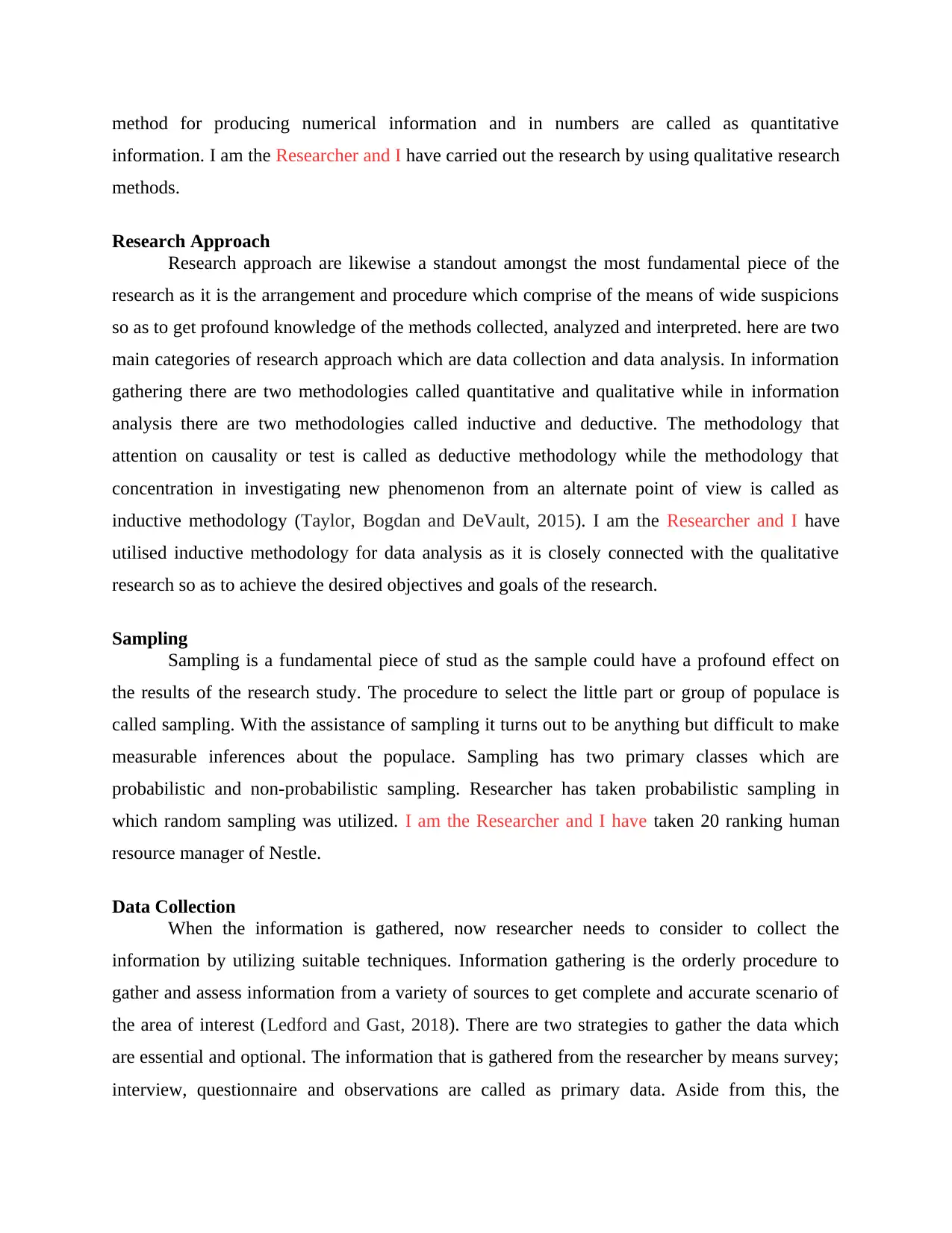
method for producing numerical information and in numbers are called as quantitative
information. I am the Researcher and I have carried out the research by using qualitative research
methods.
Research Approach
Research approach are likewise a standout amongst the most fundamental piece of the
research as it is the arrangement and procedure which comprise of the means of wide suspicions
so as to get profound knowledge of the methods collected, analyzed and interpreted. here are two
main categories of research approach which are data collection and data analysis. In information
gathering there are two methodologies called quantitative and qualitative while in information
analysis there are two methodologies called inductive and deductive. The methodology that
attention on causality or test is called as deductive methodology while the methodology that
concentration in investigating new phenomenon from an alternate point of view is called as
inductive methodology (Taylor, Bogdan and DeVault, 2015). I am the Researcher and I have
utilised inductive methodology for data analysis as it is closely connected with the qualitative
research so as to achieve the desired objectives and goals of the research.
Sampling
Sampling is a fundamental piece of stud as the sample could have a profound effect on
the results of the research study. The procedure to select the little part or group of populace is
called sampling. With the assistance of sampling it turns out to be anything but difficult to make
measurable inferences about the populace. Sampling has two primary classes which are
probabilistic and non-probabilistic sampling. Researcher has taken probabilistic sampling in
which random sampling was utilized. I am the Researcher and I have taken 20 ranking human
resource manager of Nestle.
Data Collection
When the information is gathered, now researcher needs to consider to collect the
information by utilizing suitable techniques. Information gathering is the orderly procedure to
gather and assess information from a variety of sources to get complete and accurate scenario of
the area of interest (Ledford and Gast, 2018). There are two strategies to gather the data which
are essential and optional. The information that is gathered from the researcher by means survey;
interview, questionnaire and observations are called as primary data. Aside from this, the
information. I am the Researcher and I have carried out the research by using qualitative research
methods.
Research Approach
Research approach are likewise a standout amongst the most fundamental piece of the
research as it is the arrangement and procedure which comprise of the means of wide suspicions
so as to get profound knowledge of the methods collected, analyzed and interpreted. here are two
main categories of research approach which are data collection and data analysis. In information
gathering there are two methodologies called quantitative and qualitative while in information
analysis there are two methodologies called inductive and deductive. The methodology that
attention on causality or test is called as deductive methodology while the methodology that
concentration in investigating new phenomenon from an alternate point of view is called as
inductive methodology (Taylor, Bogdan and DeVault, 2015). I am the Researcher and I have
utilised inductive methodology for data analysis as it is closely connected with the qualitative
research so as to achieve the desired objectives and goals of the research.
Sampling
Sampling is a fundamental piece of stud as the sample could have a profound effect on
the results of the research study. The procedure to select the little part or group of populace is
called sampling. With the assistance of sampling it turns out to be anything but difficult to make
measurable inferences about the populace. Sampling has two primary classes which are
probabilistic and non-probabilistic sampling. Researcher has taken probabilistic sampling in
which random sampling was utilized. I am the Researcher and I have taken 20 ranking human
resource manager of Nestle.
Data Collection
When the information is gathered, now researcher needs to consider to collect the
information by utilizing suitable techniques. Information gathering is the orderly procedure to
gather and assess information from a variety of sources to get complete and accurate scenario of
the area of interest (Ledford and Gast, 2018). There are two strategies to gather the data which
are essential and optional. The information that is gathered from the researcher by means survey;
interview, questionnaire and observations are called as primary data. Aside from this, the
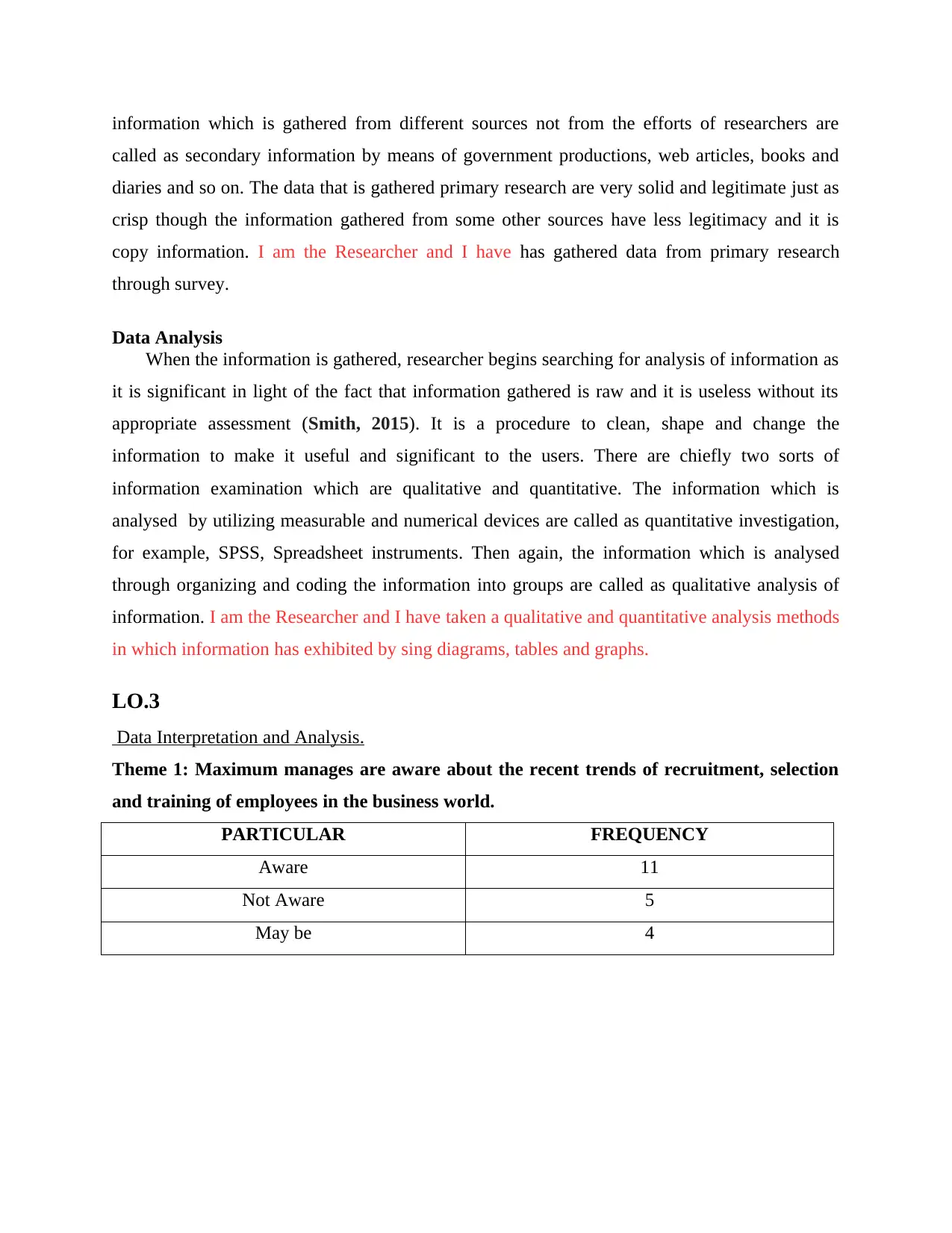
information which is gathered from different sources not from the efforts of researchers are
called as secondary information by means of government productions, web articles, books and
diaries and so on. The data that is gathered primary research are very solid and legitimate just as
crisp though the information gathered from some other sources have less legitimacy and it is
copy information. I am the Researcher and I have has gathered data from primary research
through survey.
Data Analysis
When the information is gathered, researcher begins searching for analysis of information as
it is significant in light of the fact that information gathered is raw and it is useless without its
appropriate assessment (Smith, 2015). It is a procedure to clean, shape and change the
information to make it useful and significant to the users. There are chiefly two sorts of
information examination which are qualitative and quantitative. The information which is
analysed by utilizing measurable and numerical devices are called as quantitative investigation,
for example, SPSS, Spreadsheet instruments. Then again, the information which is analysed
through organizing and coding the information into groups are called as qualitative analysis of
information. I am the Researcher and I have taken a qualitative and quantitative analysis methods
in which information has exhibited by sing diagrams, tables and graphs.
LO.3
Data Interpretation and Analysis.
Theme 1: Maximum manages are aware about the recent trends of recruitment, selection
and training of employees in the business world.
PARTICULAR FREQUENCY
Aware 11
Not Aware 5
May be 4
called as secondary information by means of government productions, web articles, books and
diaries and so on. The data that is gathered primary research are very solid and legitimate just as
crisp though the information gathered from some other sources have less legitimacy and it is
copy information. I am the Researcher and I have has gathered data from primary research
through survey.
Data Analysis
When the information is gathered, researcher begins searching for analysis of information as
it is significant in light of the fact that information gathered is raw and it is useless without its
appropriate assessment (Smith, 2015). It is a procedure to clean, shape and change the
information to make it useful and significant to the users. There are chiefly two sorts of
information examination which are qualitative and quantitative. The information which is
analysed by utilizing measurable and numerical devices are called as quantitative investigation,
for example, SPSS, Spreadsheet instruments. Then again, the information which is analysed
through organizing and coding the information into groups are called as qualitative analysis of
information. I am the Researcher and I have taken a qualitative and quantitative analysis methods
in which information has exhibited by sing diagrams, tables and graphs.
LO.3
Data Interpretation and Analysis.
Theme 1: Maximum manages are aware about the recent trends of recruitment, selection
and training of employees in the business world.
PARTICULAR FREQUENCY
Aware 11
Not Aware 5
May be 4
⊘ This is a preview!⊘
Do you want full access?
Subscribe today to unlock all pages.

Trusted by 1+ million students worldwide
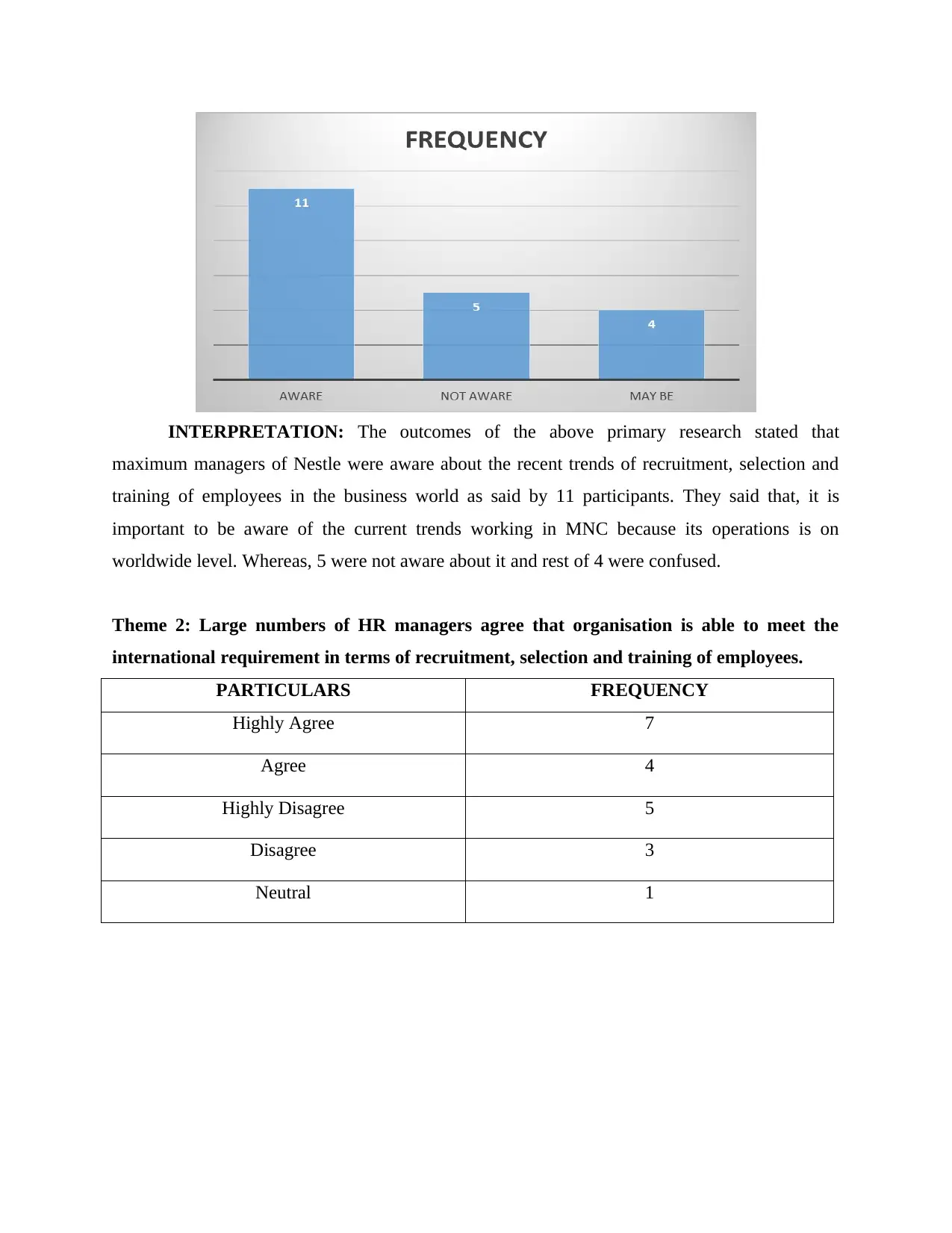
INTERPRETATION: The outcomes of the above primary research stated that
maximum managers of Nestle were aware about the recent trends of recruitment, selection and
training of employees in the business world as said by 11 participants. They said that, it is
important to be aware of the current trends working in MNC because its operations is on
worldwide level. Whereas, 5 were not aware about it and rest of 4 were confused.
Theme 2: Large numbers of HR managers agree that organisation is able to meet the
international requirement in terms of recruitment, selection and training of employees.
PARTICULARS FREQUENCY
Highly Agree 7
Agree 4
Highly Disagree 5
Disagree 3
Neutral 1
maximum managers of Nestle were aware about the recent trends of recruitment, selection and
training of employees in the business world as said by 11 participants. They said that, it is
important to be aware of the current trends working in MNC because its operations is on
worldwide level. Whereas, 5 were not aware about it and rest of 4 were confused.
Theme 2: Large numbers of HR managers agree that organisation is able to meet the
international requirement in terms of recruitment, selection and training of employees.
PARTICULARS FREQUENCY
Highly Agree 7
Agree 4
Highly Disagree 5
Disagree 3
Neutral 1
Paraphrase This Document
Need a fresh take? Get an instant paraphrase of this document with our AI Paraphraser
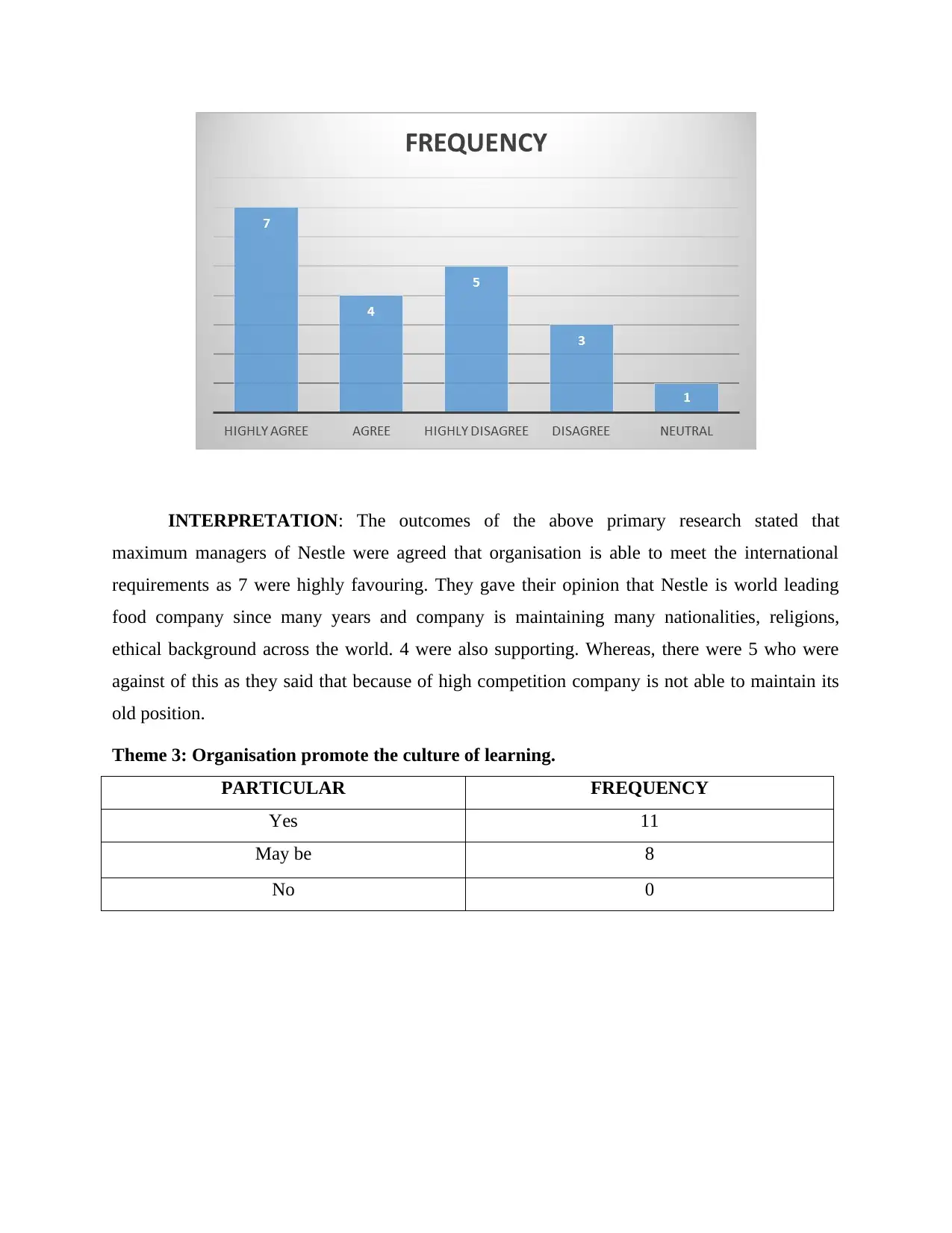
INTERPRETATION: The outcomes of the above primary research stated that
maximum managers of Nestle were agreed that organisation is able to meet the international
requirements as 7 were highly favouring. They gave their opinion that Nestle is world leading
food company since many years and company is maintaining many nationalities, religions,
ethical background across the world. 4 were also supporting. Whereas, there were 5 who were
against of this as they said that because of high competition company is not able to maintain its
old position.
Theme 3: Organisation promote the culture of learning.
PARTICULAR FREQUENCY
Yes 11
May be 8
No 0
maximum managers of Nestle were agreed that organisation is able to meet the international
requirements as 7 were highly favouring. They gave their opinion that Nestle is world leading
food company since many years and company is maintaining many nationalities, religions,
ethical background across the world. 4 were also supporting. Whereas, there were 5 who were
against of this as they said that because of high competition company is not able to maintain its
old position.
Theme 3: Organisation promote the culture of learning.
PARTICULAR FREQUENCY
Yes 11
May be 8
No 0
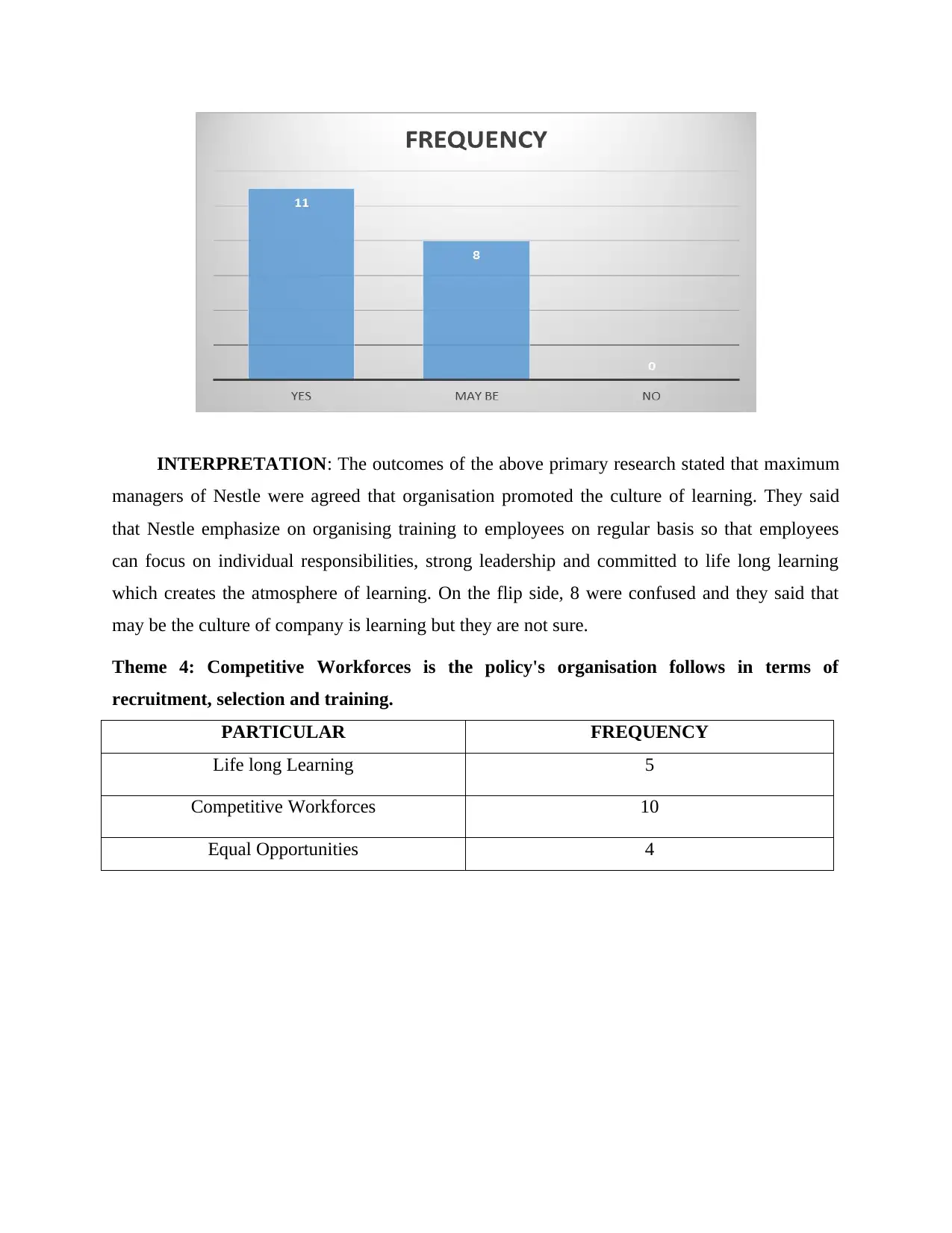
INTERPRETATION: The outcomes of the above primary research stated that maximum
managers of Nestle were agreed that organisation promoted the culture of learning. They said
that Nestle emphasize on organising training to employees on regular basis so that employees
can focus on individual responsibilities, strong leadership and committed to life long learning
which creates the atmosphere of learning. On the flip side, 8 were confused and they said that
may be the culture of company is learning but they are not sure.
Theme 4: Competitive Workforces is the policy's organisation follows in terms of
recruitment, selection and training.
PARTICULAR FREQUENCY
Life long Learning 5
Competitive Workforces 10
Equal Opportunities 4
managers of Nestle were agreed that organisation promoted the culture of learning. They said
that Nestle emphasize on organising training to employees on regular basis so that employees
can focus on individual responsibilities, strong leadership and committed to life long learning
which creates the atmosphere of learning. On the flip side, 8 were confused and they said that
may be the culture of company is learning but they are not sure.
Theme 4: Competitive Workforces is the policy's organisation follows in terms of
recruitment, selection and training.
PARTICULAR FREQUENCY
Life long Learning 5
Competitive Workforces 10
Equal Opportunities 4
⊘ This is a preview!⊘
Do you want full access?
Subscribe today to unlock all pages.

Trusted by 1+ million students worldwide
1 out of 42
Related Documents
Your All-in-One AI-Powered Toolkit for Academic Success.
+13062052269
info@desklib.com
Available 24*7 on WhatsApp / Email
![[object Object]](/_next/static/media/star-bottom.7253800d.svg)
Unlock your academic potential
Copyright © 2020–2025 A2Z Services. All Rights Reserved. Developed and managed by ZUCOL.





